
Starfish or sea stars are star-shaped echinoderms belonging to the class Asteroidea. Common usage frequently finds these names being also applied to ophiuroids, which are correctly referred to as brittle stars or basket stars. Starfish are also known as asteroids due to being in the class Asteroidea. About 1,900 species of starfish live on the seabed in all the world's oceans, from warm, tropical zones to frigid, polar regions. They are found from the intertidal zone down to abyssal depths, at 6,000 m (20,000 ft) below the surface.

The Echinasteridae are a family of starfish in the monotypic order Spinulosida. The family includes eight genera and about 133 species found on the seabed in various habitats around the world.

Solaster paxillatus, the orange sun star, is a species of starfish found at varying depths in the northern Pacific Ocean. It is a natural predator of the starfish Asterias amurensis.
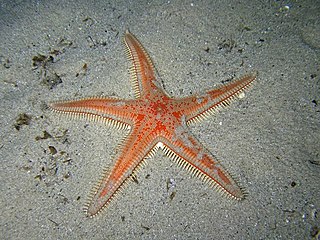
Astropecten aranciacus, the red comb star, is a sea star of the family Astropectinidae. It is native to the east Atlantic Ocean and the Mediterranean Sea.

Astropecten irregularis is a sea star of the family Astropectinidae. Common names include Sand sea star.

Astropecten platyacanthus is a sea star of the family Astropectinidae.
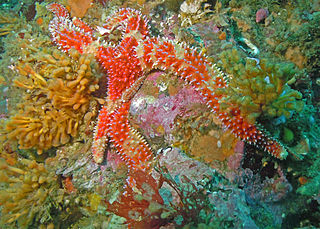
Orthasterias is a genus of sea stars in the family Asteriidae. Orthasterias koehleri, the rainbow star or red-banded sea star, is the only species in the genus. It is found in the North Pacific Ocean.

The orange knobby star, Echinaster echinophorus, is a species of sea star found in the Caribbean Sea and along the Atlantic coast of South America.
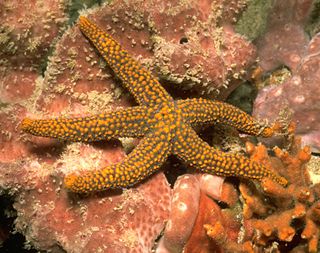
Echinaster spinulosus, the small spine sea star, is a species of sea star found in shallow parts of the western Atlantic Ocean, the Caribbean Sea and Gulf of Mexico.

The spiny sand seastar is a species of starfish in the family Luidiidae. It is found in shallow parts of the China Sea and in the vicinity of the Korean archipelago. The tissues of this starfish have been found to contain several secondary metabolites with medicinal potential.

Astropecten armatus, the spiny sand star or Estrella de Arena, is a sea star in the family Astropectinidae. It is found on sandy or gravelly areas in the East Pacific ranging from California (USA) to Ecuador.
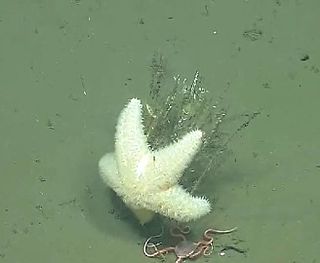
Poraniopsis inflata, the spiny sea star, is a species of starfish in the family Poraniidae. It is native to the Pacific Ocean and is found in deep water off the coast of North America.

Astropecten duplicatus, the two-spined sea star, is a starfish in the family Astropectinidae. It is found in the eastern Atlantic Ocean, the Caribbean Sea and the Gulf of Mexico.
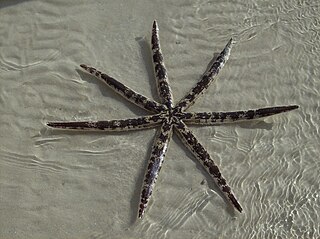
Luidia maculata is a species of starfish in the family Luidiidae in the order Paxillosida. It is native to the Indo-Pacific region. It is commonly known as the eight-armed sea star because, although the number of arms varies from five to nine, eight arms seems to be the most common.
Paulasterias mcclaini is a species of starfish in the family Paulasteriidae. It is found in deep water at hydrothermal vents.

Asterodiscides truncatus, the firebrick starfish, is a species of five-armed starfish in the family Asterodiscididae. It is native to eastern and southern Australia, the Norfolk Ridge and the Kermadec Islands of New Zealand.

Neoferdina cumingi, also known as Cuming's sea star, is a species of starfish in the family Goniasteridae. It is native to the tropical Indo-Pacific region.

Echinaster luzonicus, the Luzon sea star, is a species of starfish in the family Echinasteridae, found in shallow parts of the western Indo-Pacific region. It sometimes lives symbiotically with a copepod or a comb jelly, and is prone to shed its arms, which then regenerate into new individuals.

Coeloplana astericola, the creeping comb jelly, is a species of benthic comb jelly from the tropical western Indo-Pacific region that lives as an episymbiont on starfish such as Echinaster luzonicus.

Asterina pancerii, commonly known as the seagrass asterina, is a species of starfish in the family Asterinidae. It is native to shallow parts of the Mediterranean Sea where it is usually found in seagrass meadows.


















